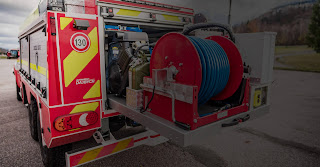Electric Car Fires: Separating Fact from Fiction
As electric cars (EVs) become more common, questions about
their fire safety have surfaced. To grasp the reality of electric car fires, it
is important to distinguish fact from fantasy. In order to allay these worries,
let's examine some widespread myths and offer correct facts.
·
Myth: Fires are more likely to start in electric
cars than in conventional ones.
Factual statement: Fire risks are not
intrinsically higher for electric cars. Even though EV batteries have special
concerns, they go through extensive safety testing and are built to reduce and
avoid fire dangers. In truth, statistics show that compared to ICE cars, the
occurrence rate of fire in electric vehicles is often lower.
·
Myth: It's difficult to put out flames with
electric cars.
Factual statement: While the extinguishing
procedure for electric car fires may be different from that for typical vehicle
fires, it is still possible to put them out successfully with the right methods
and tools. Emergency personnel undergo specialised instruction to handle EV
fire situations, including understanding of battery chemistry and proficiency
with EV-specific fire control equipment.
·
Myth: When there's a fire, the batteries in
electric cars blow out.
Explosions in EV batteries are unbelievably
infrequent. Electric car lithium-ion batteries are built with safety mechanisms
to guard against disastrous failures. Thermal runaway, which can result in
explosions in a fire, is an uncommon phenomenon. Emergency personnel are
trained to properly manage EV fires, including firefighters.
·
Myth: Toxic gases are released during electric
car burns.
Factual statement: The gases produced by an
EV fire are comparable to those produced by a conventional car fire. Plastics
and metals, two common components in EV fires, have the potential to emit
harmful smoke and chemicals. Protocols for emergency response, however, are
intended to lessen exposure hazards for first responders and the general
public.
·
Myth: It's impossible to avoid fires in electric
vehicles.
Fact: To prevent fires, electric car
manufacturers take several precautions. Modern battery management systems keep
an eye on and control battery temperature to lower the chance of overheating.
The safety and dependability of EV batteries are also guaranteed through
systems for testing and certifying battery cells. Collaboration and ongoing
research help to make fire protection technologies better all the time.
·
Myth: People inside of electric vehicles are
seriously at risk from flames.
Fact: Compared to fires in regular vehicles,
electric car fires do not put passengers at greater danger. Strong safety
mechanisms, such as automated battery disconnects and fire suppression systems,
are included in EVs. These security measures lessen the risk of a fire and
safeguard the residents.
·
Misconception: The fire safety requirements for
electric cars are uniform.
Fact: EV-specific safety requirements and
laws are complied with by electric car manufacturers. These requirements
include things like fire prevention, collision safety, and battery design. In
order to assure compliance and foster customer confidence, independent
organizations also carry out safety testing and certification procedures.
It is crucial to understand that, despite being uncommon, EV
fires can happen. The fire safety of electric cars has, however, been much
improved because to developments in battery technology, safety laws, and
emergency response procedures. The prevention, detection, and response to fires
are improved by cooperative efforts between manufacturers, researchers, and
first responders.
When it comes to electric car fires, differentiating reality
from myth depends critically on public awareness and education. It will be
easier to foster trust in the security of electric cars and encourage their
further acceptance if emergency responders are trained, the safety mechanisms
in place are understood, and myths are dispelled.
In conclusion, electric car fires are comparatively uncommon and aren't necessarily much riskier than fires in conventional vehicles. We can make sure that electric cars continue to be a secure and environmentally friendly means of transportation by putting an emphasis on correct information, continued study, and improvements in fire safety equipment.


Comments
Post a Comment